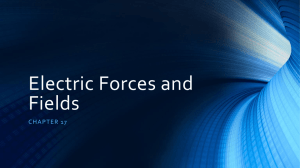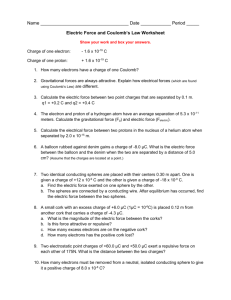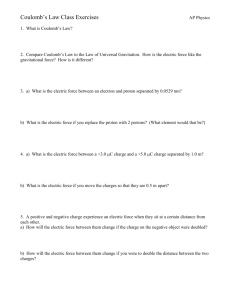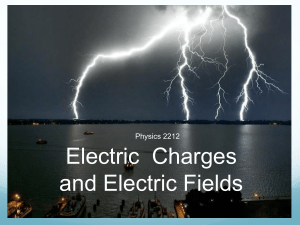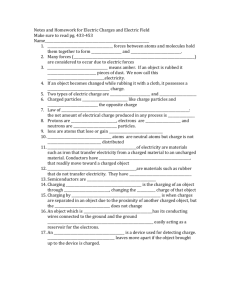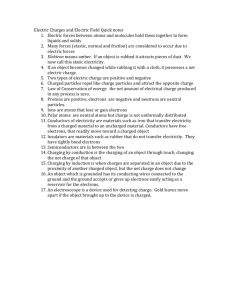Methods of Charging
advertisement
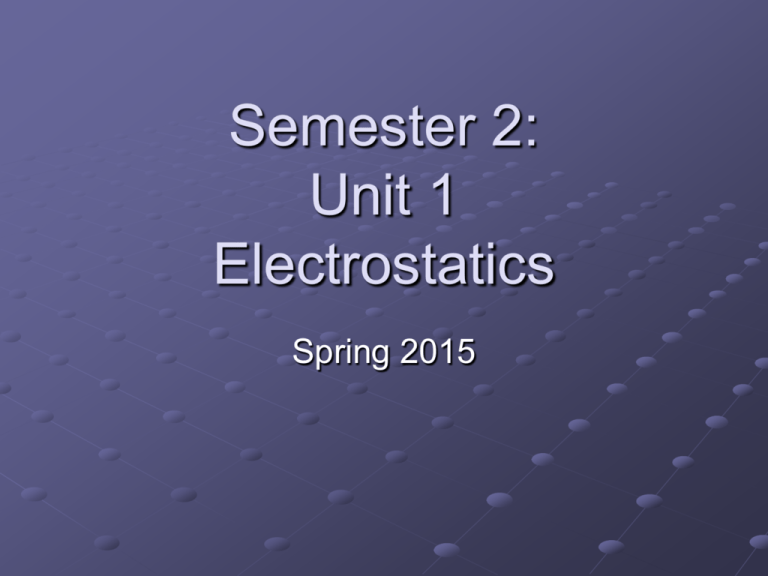
Semester 2: Unit 1 Electrostatics Spring 2015 Agenda 1/20/15 Welcome! Seating Chart Name Game Info Sheets Introduction to Electrostatics Activity What do you know about this stuff? Seating Chart Arrange yourselves in alphabetical order ACROSS each ROW. You have 2 minutes GO!! Agenda 1/21/15 Double Period Collect Signed Syllabi Complete Intro to Electrostatics Lab Think about: What causes charge? In what ways can charge build up? Discuss findings from activity Notes on types of charging Begin Types of charging lab HW: Complete analysis and conclusion of lab Let’s talk What are the parts of an atom? Which part moves most easily? What is a conductor? Examples? What is an insulator? Examples? Big Question: What makes something a conductor or an insulator? Methods of Charging Chapter 19 Conductors vs. Insulators Conductor: allows charge flow easily Metals Insulator: doesn’t allow charge flow easily Glass, dry wood, cloth, air, most plastics Like Charges & Unlike Charges Charge moves due to motion of electrons Electrons are negatively charged When two materials +, repel When two materials -, repel When one material + and one material -, attract Charging by Conduction Redistribution of charge by direct touching together of two objects Made easier/quicker if both are electrical conductors Originally uncharged material gets same charge concentration as originally charged material if contact between the two exists for a long period of time Charging by Conduction Charging by Friction When two initially uncharged materials make contact, the better conductor grabs the electrons from the better insulator In the process, both become charged Substance w/more electrons becomes negative; other becomes positive Charging by Friction High affinity for electrons (conductors) Low affinity for electrons (Insulators) Charging by Induction Charge accumulates on originally uncharged material due to a charged material being placed nearby the uncharged material at the same time as a ground is established. Induction Example: Grounding Induction Example: Contact Induction Example: + Charge Induction by Polarization Polarized: the + and – charges are not evenly distributed in a material (+ pole and – pole) When the charged material is an insulator (non-conducting), polarization occurs in the conductor and the two materials are attracted Cellophane on plastic, balloon on shirt Induction by Polarization Agenda 1/22/15 Complete Types of Charging Lab At least 2 Problem Solving Activities Show off Physics Skills Lab Exit Slip Forces and Free Body Diagram Intro HW: FBD Practice 1 Agenda 1/23/15 Physics Phriday Discuss Types of Charging Analysis Turn in lab Intro to Free Body Diagrams Practice Coulomb’s Law Lab Netbook activity HW: Complete Coulomb’s Law Lab Analysis Before we start On a separate sheet of paper: Tell me the 4 types of charging AND Draw an example of each type Agenda 1/26/15 Complete Coulomb’s Law Lab Graphing Hints Build Coulomb’s Law Practice problems with C.L. HW: Finish Write-Up for C.L. Lab Graphing Hints Indirect Relationship F=x F = -x Inverse Square F =1/x2 Inverse Relationship F = 1/x Agenda 1/27/15 Discuss Coulomb’s Law Lab Determine the flaw in the program Complete Lab Notes on Coulomb’s Law Practice Problems for CL HW: Finish Write-Up for C.L. Lab Coulomb’s Law FE = k|q1||q2| / r2 k = Coulomb’s Constant = 9.0 x 109 Nm2/C2 q1 & q2: Charges in coulombs (C) r = distance from center of one charge to center of the opposite charge (m) If charges opposite, then attractive If charges like, then repulsive force Equal force upon both objects (Newton’s 3rd Law) Opposites Attract, Likes Repel Inverse Square Law Like with sound intensity, there is an inversesquare relationship between force and distance of separation Fundamental Charge When an atom ionizes to +1 or -1 in chemistry, how much charge does this represent in coulombs? +1 in chem = 1.60 x 10-19 C = e 1.60 x 10-19 C is smallest quantified charge Proton = 1.60 x 10-19C, electron = -1.60 x 10-19C Also called elementary charge Net Charge The net charge equals the (number of extra or deficient electrons) x ( +/- 1.60 x 10-19 C) q = Ne If you have a substance with 5 extra electrons, then q = (5) (-1.6 x 10-19 C) = -8.0 x 10-19 C Net Charge What is the net charge in Coulombs of a... Fe atom? Fe2+ ion? Fe3+ ion? Charge amounts are always simple whole number multiples of the fundamental charge! Coulomb’s Law in an Atom What is the average electric force between a proton and an electron in a hydrogen atom? (average distance of separation between p+ and e- is 5.3 x 10-11 m) Answer is 39 orders of magnitude greater than gravitational attraction between the two! Agenda 1/28/15 Doubles Turn in Coulomb’s Law Lab Final Questions Lab Exit Slip next period Practice Net Charge and CL Practice Problems for CL Practice Net Charge Review Everything up to now HW: Study for Quiz Tomorrow Agenda 1/29/15 Discuss the Review Worksheet Types of Charging Coulomb’s Law Review Activity for types of charging Brief Review Quiz HW: None for tonight Agenda 1/30/15 Review Electrostatics Quiz Amount of Electrons on a Balloon Lab q = Ne More Force Practice…maybe HW: Write up the balloon lab Agenda 2/4/15 Pass Back A LOT!! Collect Balloon Lab from the rest Electric Field PhETs Field of Dreams and Field Hockey Notes of E-Fields and Diagrams Practice Problems HW: Complete E-Field WS Electric Fields Vector quantity Relates the force exerted on a positive test charge to the size of the test charge Changes with location Unit: N/C E = Coulomb’s force on q’ q’ E = FE q’ Example Problem What is the strength and direction of the electric field 0.250m to the right of a 1.00C electric charge? What is the strength of the field .250m to the left of the same charge? .250m above the same charge? Electric Field Lines Arrows show the force direction acting upon a positive test charge The more field lines per area, the more intense the electric field is. Notice that arrows flow out of the positive charge. Electric field lines: Multiple Charges Charges of opposite sign display a watermelon or footballshaped field line structure between them. Again, arrows flow out of + and into - Electric field lines: Multiple Charges Charges of same sign display a diamondshaped field line structure between them. Electric field lines: Multiple Charges Show field lines entering or leaving each charge in the ratio of the relative magnitudes of the charges. •Above, red charge (+) has 12 lines leaving, blue charge (-) has 6 lines entering, so red charge must have double the magnitude that the blue charge possesses. Electric field lines: Multiple Charges More powerful charge tends to dominate the less powerful one and change the basic watermelon/ diamond shape. Electric Field Lines: Charged Conductors Two oppositelycharged conducting plates have field lines roughly linear between them and rounded off their edges. Rules Recap for Drawing EField Lines 1. Don’t have field lines cross. 2. Have the same ratio of lines entering/exiting charges as the ratio of the magnitude of the charges 3. Have at least 3 lines entering/exiting all charges 4. Best amount of field lines per charge is from 4-12 lines. Two Charge Examples

